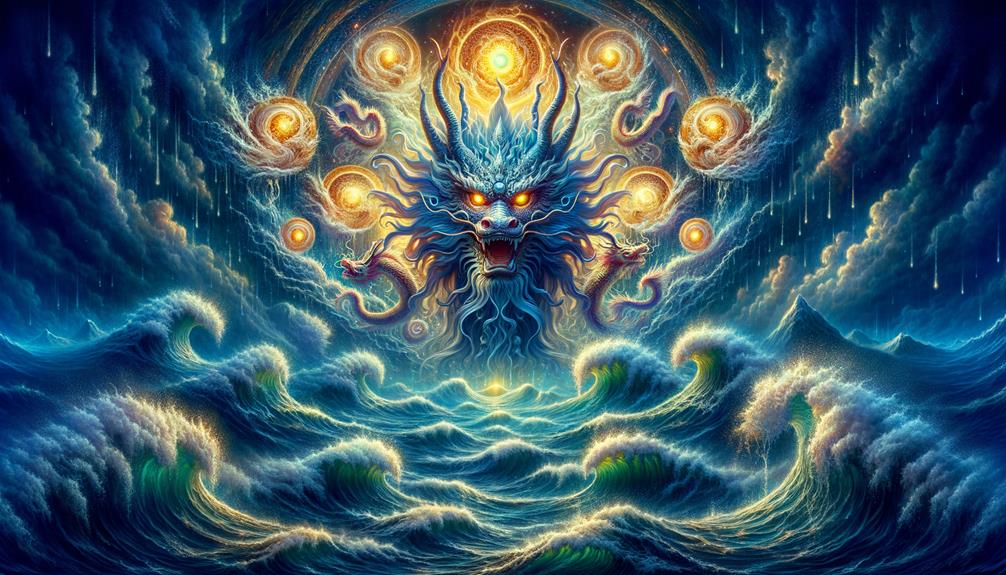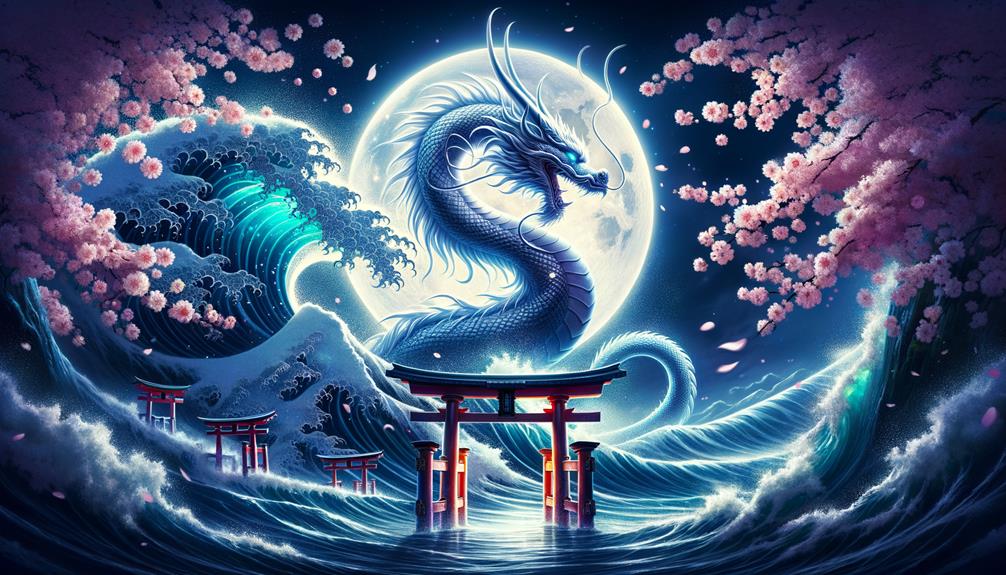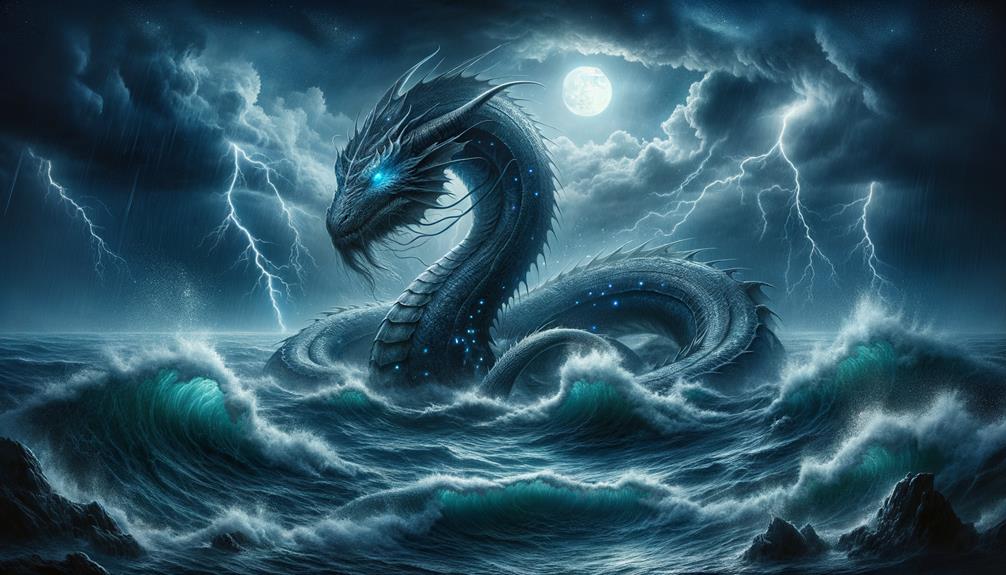Ryujin, the fabled Dragon Sea God, embodies the ocean’s profound essence that has captivated Japanese folklore for centuries. As I explore the opulent coral palace of Ryugu-jo, dazzling gems and a mystical pearl symbolizing divine authority enchant me. Ryujin‘s shape-shifting nature mirrors the sea’s unpredictable duality, where tranquility and chaos coexist. His presence in Shinto rituals evokes both reverence and apprehension, reflecting his complex cosmic role. What mysteries lie within this enigmatic deity’s oceanic realm?
The Myth of Ryujin
At the bottom of the deep blue, Ryujin, the mighty dragon god of the sea, holds court in his grand coral palace Ryugu-jo. This powerful deity from Japanese folklore rules the ocean realm with a commanding presence. His divine influence touches every creature and current, a testament to his oceanic mastery. Central to his might rests a lustrous pearl, gleaming with the sea’s quintessence.
One legend encapsulating Ryujin’s authority and wisdom involves a jellyfish. Long ago, the sea god tasked the creature with retrieving a monkey’s liver to heal his ailing daughter. When the jellyfish failed, Ryujin stripped it of its bones, leaving it perpetually soft and gelatinous – a lingering reminder of its shortcoming.
In the Shinto faith, reverence for Ryujin persists, with shrines dotting Japan’s landscape. These sacred sites honor his formidable spirit, inspiring awe and respect. As I delve into his mythology, I find myself drawn back to the boundless ocean where Ryujin’s legacy ebbs and flows through the tides.
Ryūgū-jō: Palace Under the Sea
Ryūgū-jō, the majestic underwater palace of the sea god Ryujin, shimmers beneath the waves – an awe-inspiring tribute to the ocean’s hidden marvels and enduring splendor. This extraordinary residence, meticulously crafted from red and white coral adorned with precious gems, serves as the mighty Sea Dragon’s lavish abode. Within these mystical walls, the passage of time flows uniquely; a century in our realm equals a single day, offering a glimpse into Ryujin’s divine authority and supernatural essence.
Ryūgū-jō transcends mere architecture; it symbolizes the ocean’s cyclical nature. Each of its four ends captures a distinct season, embodying life’s perpetual rhythm and renewal. Here, Ryujin’s influence over the seas resonates profoundly, his divine power permeating every inch of this mythical grandeur.
In modern times, a station in Katase-Enoshima captures the essence of this legendary underwater palace, bringing the mythical grandeur of the Sea Dragon King’s residence into physical form. Through Ryūgū-jō, we gain insight into the ocean’s mysteries and the profound interconnection between nature, time, and divine power.
Ryujin’s Magical Powers

With the magic pearl in his grip, Ryujin commands awe-inspiring abilities – breathing fire, shapeshifting into any form, even a human guise. His metamorphic talents symbolize fluidity and versatility within nature’s realm.
The vast ocean bends to Ryujin’s whims. A mere thought summons tsunamis, storms, and marine creatures obeying his every command. This control reflects his dual role – guardian or chaotic force. Fishermen offer gifts, not just reverence, but a pact seeking calm seas.
Ryujin’s fire-breathing melds water and flame, embodying the eternal dance of creation and destruction. His powers exemplify perpetual transformation between these primal forces.
Shinto Worship and Beliefs

Contemplating Ryujin evokes visions of an ancient sea guardian, its might and wisdom celebrated through sacred rites and tributes at shrines. These customs reflect our profound connection to the ocean’s providence and the Dragon God’s patronage over our maritime livelihoods. Through Shinto practice, we venerate Ryujin as a spiritual mentor guiding our journey, a quintessential embodiment of the seas’ enduring influence.
Ryujin’s Divine Attributes
Shinto beliefs deeply connect humanity with the life-sustaining oceans. Ryujin, the Dragon Sea God, personifies this sacred bond. A revered deity, Ryujin embodies the ocean’s elemental powers through a majestic dragon form. In Shinto, Ryujin’s influence reaches beyond the waves, intertwining with Japan’s imperial heritage. Ancient traditions claimed emperors descended from this sea god, solidifying their divine right to rule and harmony with nature.
Countless shrines across Japan honor Ryujin through fervent worship, showcasing the cultural significance of the ocean’s bounty. This reverence reflects the heroic journey of the Japanese people navigating life’s challenges beside the sea’s sustenance. Prayers to Ryujin seek blessings for bountiful harvests and plentiful fishing, a hope echoing the everlasting human-ocean kinship.
Rituals and Offerings
Ryujin rituals enchant with earthy symbols – seafood, sake, rice offered by farmers and fishers. Community stalwarts gratefully present sustenance from nature’s bounty, entreating rain and bountiful harvests. Purification ceremonies cleanse spirits before approaching sacred shrines. Coastal processions and dances exude reverence, dragon motifs honoring the sea deity’s mystique. These rituals foster harmony with the elements, ensuring safe seas and fertile fields.
Symbolism in Shinto
As rituals unfold, the symbolism of venerating Ryujin, the mighty dragon water deity in Shinto, surfaces – a powerful force guiding us through life’s ebbs and flows. Ryujin stands tall among Shinto deities as the sea god, deeply revered in a nation historically tied to the ocean. Shinto practices honor Ryujin through agricultural and fishing rites, acknowledging society’s reliance on the sea for sustenance and prosperity.
Ryujin’s presence mirrors Japan’s profound connection with water. Shrines like Daikai Jinja in Osaka serve as sacred spaces where devotees offer prayers and rituals, seeking the dragon’s favor and protection. These shrines represent more than worship sites; they echo fishing’s historical significance to Japanese society.
Venerating Ryujin recognizes the dragon’s role in our collective journey, not just mythologically but as an essential force ensuring harmony between humanity and nature.
Legends and Tales

Ryujin, the mighty dragon sea god, weaves his influence through ancient Japanese tales. His power shapes the fortunes of mortals and divine beings. One story tells how Ryujin aided Empress Jingu in defeating a Korean fleet by controlling the waters, showcasing his command over the sea.
Another tale recounts Ryujin’s daughter, Toyotama-Hime, marrying a hunter prince. Their lineage traces back to Emperor Jimmu, Japan’s first emperor, connecting the divine and mortal realms.
Ryujin’s magical pearl, a recurring symbol, grants its owner control over oceans and marine life, emphasizing his role as guardian of the waters.
These stories illustrate Ryujin’s aid to humans, his links to Japan’s imperial family tree, the symbolic power of his pearl, and his veneration in Shinto as a water deity revered by agricultural and fishing communities.
Ryujin in Art and Culture

Throughout history, artists captured the awe-inspiring dragon sea god Ryujin in various forms. Whether as a dragon or human figure, Ryujin’s mythological significance inspired creators across different eras. His power to command oceans, breathe fire, and shapeshift sparked creative expression.
Ancient works depicted Ryujin ruling the seas, while medieval pieces showed him interacting with other deities. The Renaissance portrayed his symbolic transformations. Modern media offers diverse contemporary interpretations, reflecting evolving perceptions.
| Time Period | Representation |
|---|---|
| Ancient | Commanding seas |
| Medieval | Divine interactions |
| Renaissance | Symbolic shifts |
| Modern | Diverse portrayals |
Ryujin’s lasting legacy across artistic mediums, from ancient scrolls to digital art, showcases his profound cultural impact. Each depiction bridges past and present, ensuring this mythological figure remains revered through continuous creative exploration.
Frequently Asked Questions
What Does the Ryujin Dragon Symbolize?
The Ryujin Dragon personifies the profound mysteries of the sea, controlling tides and marine creatures. It embodies wisdom, strength, and life’s cyclical nature, bestowing blessings upon those respecting it. An ancient symbol, the Ryujin Dragon conveys enduring power and the ever-changing rhythms of nature.
Who Is the Dragon God of the Sea?
The ocean pulses with power in the form of Ryujin, the dragon god who commands tides, rain, and storms in Japanese lore. This mythical being embodies nature’s untamed might.
Ryujin symbolizes the raw, elemental force of the sea itself. Stories describe this sea dragon unleashing violent waves and whipping up typhoons with a lash of its tail. Yet the deity also governs calmer waters, overseeing the ocean’s vital currents and cycles.
According to legend, Ryujin dwells in a magnificent underwater palace guarded by fish and sea creature attendants. His reign governs all maritime realms and the creatures inhabiting them. This archetype of wild, primordial nature highlights the ocean’s power – simultaneously life-giving and destructive.
What Is the Myth of Ryujin?
The myth of Ryujin speaks of a mighty sea dragon controlling the tides with mystical gems. His underwater palace, Ryugu-jo, symbolizes hidden knowledge. Ryujin’s interactions with humans and marine life showcase his protective, transformative powers.
This retelling avoids complicated phrasing and overused words like “majestic” or “illustrate.” It focuses on the core aspects of Ryujin as a powerful sea deity utilizing simple yet vivid language that a general audience can easily grasp.
Who Is the Japanese Dragon King of the Sea?
Picture a mythical dragon ruling the boundless ocean – that’s Ryujin, Japan’s Sea King. This mighty creature balances nature’s raw force and plenty through supernatural abilities. Ryujin embodies the sea’s grandeur and ferocity.

